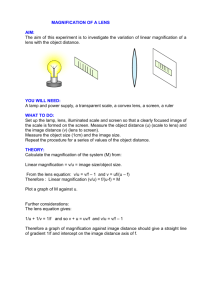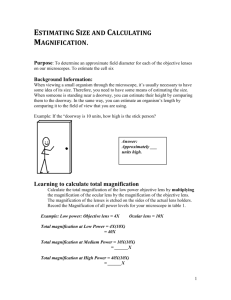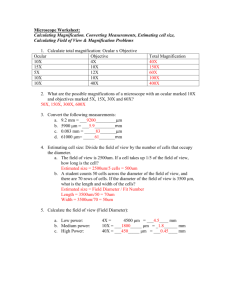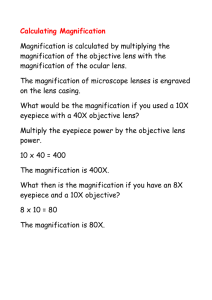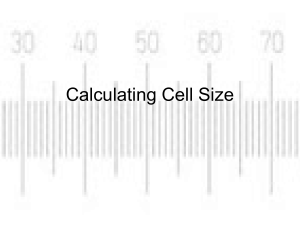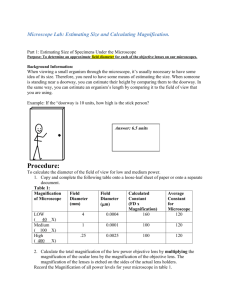Determining the actual size of microscopic objects
advertisement
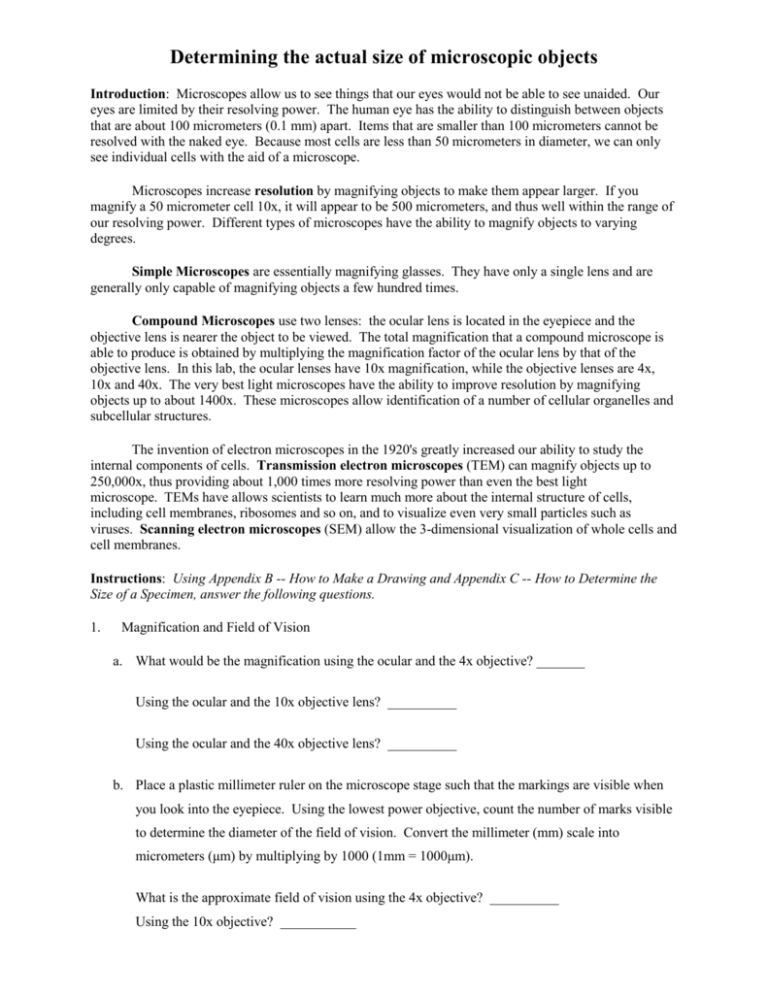
Determining the actual size of microscopic objects Introduction: Microscopes allow us to see things that our eyes would not be able to see unaided. Our eyes are limited by their resolving power. The human eye has the ability to distinguish between objects that are about 100 micrometers (0.1 mm) apart. Items that are smaller than 100 micrometers cannot be resolved with the naked eye. Because most cells are less than 50 micrometers in diameter, we can only see individual cells with the aid of a microscope. Microscopes increase resolution by magnifying objects to make them appear larger. If you magnify a 50 micrometer cell 10x, it will appear to be 500 micrometers, and thus well within the range of our resolving power. Different types of microscopes have the ability to magnify objects to varying degrees. Simple Microscopes are essentially magnifying glasses. They have only a single lens and are generally only capable of magnifying objects a few hundred times. Compound Microscopes use two lenses: the ocular lens is located in the eyepiece and the objective lens is nearer the object to be viewed. The total magnification that a compound microscope is able to produce is obtained by multiplying the magnification factor of the ocular lens by that of the objective lens. In this lab, the ocular lenses have 10x magnification, while the objective lenses are 4x, 10x and 40x. The very best light microscopes have the ability to improve resolution by magnifying objects up to about 1400x. These microscopes allow identification of a number of cellular organelles and subcellular structures. The invention of electron microscopes in the 1920's greatly increased our ability to study the internal components of cells. Transmission electron microscopes (TEM) can magnify objects up to 250,000x, thus providing about 1,000 times more resolving power than even the best light microscope. TEMs have allows scientists to learn much more about the internal structure of cells, including cell membranes, ribosomes and so on, and to visualize even very small particles such as viruses. Scanning electron microscopes (SEM) allow the 3-dimensional visualization of whole cells and cell membranes. Instructions: Using Appendix B -- How to Make a Drawing and Appendix C -- How to Determine the Size of a Specimen, answer the following questions. 1. Magnification and Field of Vision a. What would be the magnification using the ocular and the 4x objective? _______ Using the ocular and the 10x objective lens? __________ Using the ocular and the 40x objective lens? __________ b. Place a plastic millimeter ruler on the microscope stage such that the markings are visible when you look into the eyepiece. Using the lowest power objective, count the number of marks visible to determine the diameter of the field of vision. Convert the millimeter (mm) scale into micrometers (μm) by multiplying by 1000 (1mm = 1000μm). What is the approximate field of vision using the 4x objective? __________ Using the 10x objective? ___________ c. Using the diameter of the field of vision determined for one of the low power objective lenses, calculate the following: (dia A)(mag A) = (dia B)(mag B) What is the diameter of the field of vision using the 40x lens? ________ What would the diameter of the field of vision be if you were using a 100x lens? _________ d. When you know the size of the field of vision, it is possible to estimate the size of an object you're looking at, i.e., 1/2 the diameter of the field of vision, 1/4 the diameter of the field of vision, and so on. Choose a prepared slide showing individual cells. View a single cell first with the 4x objective lens, then with the 10x and the 40x objective lenses. How does the image of the cell change relative to the field of vision as the magnification increases? Estimate the size of the cell by dividing the diameter of the field of vision at high magnification by the portion of the field of vision the cell takes up (i.e. if it takes up 1/4 the diameter of the field of vision, divide by 4). 2. Viewing Prepared Slides -- Choose two prepared slides from the ones provided by your instructor. Draw simple line drawings of each slide as viewed with the 10x and the 40x objective. Label your diagrams with the specimen, drawing magnification and scale. Image 1 with 10X objective Image 2 with 40X objective Magnification_________ Magnification_________ Scale Bar: Scale Bar: 3. How to Stain a Slide: Step 1. Prepare a wet mount slide of your specimen. Place one drop of Methylene Blue stain on one edge of the coverslip, and the flat edge of a piece of paper towel on the other edge of the coverslip. The paper towel will draw the water out from under the coverslip, and the cohesion of the water (due to those perennial favorites - Hydrogen Bonds) will draw the stain under the coverslip. Step 2. As soon as the stain has covered the area containing the specimen you are finished. The stain does not need to be under the entire coverslip. If the stain does not cover the area needed, get a new piece of paper towel and add more stain until it does. Step 3. Be sure to wipe off the excess stain with a paper towel, so you don’t end up staining the lenses. 1. You are now ready to place the slide on the microscope stage. Be sure to follow all the instructions on the previous pages as to how to use the microscope. 2. Using a toothpick, scrape off some of your cheek cells by rubbing the toothpick along the inside of your cheek. 3. Make a wet-mount slide of the cheek cells and dye them with the methylene blue. 4. View your wet-mount slide using the microscope and make a drawing of what you see using the 10X and 40X objectives. Make sure to label each drawing with the total magnification and the scale for your drawing. 5. When you have completed your drawings, be sure to wash and dry both the slide and the coverslip and return them to the correct places! 6. All slides must be put away in the proper trays! No one leaves until all materials have been put way properly. Image with 10X objective Image with 40X objective Magnification_________ Magnification_________ Scale Bar: Scale Bar: Magnification Problem Set (Practice) Use your estimated field diameters for our microscopes to complete the following: 1. A cell is observed to stretch half way across the high power field. How long is the cell? 2. A Paramecium is observed to travel across the low power field in 5 seconds. Calculate its speed in m/s. 3. 15 cells are observed across the center of the high power field. How long is each cell? 4. A cell is observed under high power to be about half the field diameter. A student draws the cell 25cm in length. What is the magnification of the drawing? 5. A student draws a cell diagram 24mm long. She writes 400X below the diagram. How large is the actual cell? 6. A cell is 80 m in length. If drawn 600 times actual size, how long will the drawing be in cm? 1. 5 onion cells are counted across the center of the high power field. One cell is drawn 18mm long. Calculate the drawing magnification. 2. 40 potato cells are counted across the center of the medium field of view. One cell is drawn 2cm long. What is the drawing magnification? 3. A fine hair is estimated to be in diameter, one tenth of the diameter of the high power field. It is drawn 4cm wide by a student. What is the drawing magnification? 4. Copy the chart and complete: Drawing Size Actual Size 10mm 100m 4mm 10cm Drawing Magnification 3X 25X 150mm 15m 0.8cm 8m
